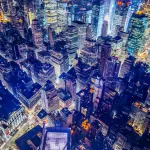Not only a catchy slogan, urban sustainability in cities is a fundamental concept that will affect the future expansion of societies all around. Demand for long-term solutions for problems in the industry, the environment, and society as well as rising cities reflect Urban sustainability aims to build communities that can meet the requirements of their citizens without consuming excessive amounts of resources or endangering the environment.
What is definitely crucial in urban sustainability?
More over, half of all individuals living on Earth are found in cities. Over the next few decades, this figure most likely will keep rising. As they expand, several issues including human inequality, resource depletion, and increasing pollution appear for them. Urban sustainability seeks to correct this as well by pushing environmentally friendly city design, green urban planning, and eco-friendly city expansion. Should cities give sustainability top priority in their design and development, they could enhance the quality of life for their residents and have less impact on the surroundings.
Absolute necessity is the reduction of greenhouse gas emissions. Among the main objectives of urban sustainability is this. Cities are main worldwide sources of carbon emissions. This is shaped by their attitude to commerce, energy use, and mobility. Sustainable urban design seeks to reduce these emissions by means of numerous facets. Among these are individuals advocating public transit, others enabling buildings to consume less energy, and still others supporting the growth of renewable energy sources. By means of these activities, towns contribute to combat climate change and reduce their carbon emissions.
Green urban design is first step towards extended town lifespan.
Creating cities to last depends on very careful urban planning. This approach enables cities to be constructed with regard for their surroundings; new cities are created using ideas of green building. Green urban design makes use of numerous factors, including green places, sustainable transportation, and fewer energy-consuming buildings, so generating sites that are both functional and good for the environment.
Mostly depending on adding parks and other green areas into cities, green urban design is These areas are quite beneficial since they provide stage locations for performance, reduce city heat, and enhance the air quality. By providing a natural location for individuals to unwind and interact with surroundings, green zones inside cities also help to improve the health of the local residents. Urban animals also call parks and other rich environments home. This makes the metropolitan surroundings interesting.
Ecologically conscious urban planning also depends quite heavily on choosing long-lasting mobility options. Since fossil fuel-powered cars are a major contributor to greenhouse gas emissions in cities, limiting their use is crucial for urban sustainability. Human-fitting walking paths, bike lanes, and public transit enable communities increase environmentally friendly mobility. By motivating people to walk or ride bikes and thereby reduce road congestion, the decisions help to improve the air quality and everyone’s health.
Constructing buildings requiring less energy largely focuses on creating livable communities. Many of the city buildings serve as the source of the used energy. Energy-saving technologies and strategies let cities help to reduce this by themselves. Less energy-consuming buildings help to also keep consumer and company energy bills down. This helps to minimize the expense of city life and lessens environmental impact.
Creating ecologically sustainable communities and enabling expansion at the same time
Less energy-consuming buildings and green areas not only contribute to the sustainability of a city. It implies creating communities where the surroundings are simultaneously preserved and the local economy is stimulated. This helps you to consider how long-term urban expansion would affect people and the surroundings. This helps towns to flourish free from possible harmful effects.
Creating long-lasting communities calls for careful consideration on various elements, including this one. The concept is to create basic, packed areas for easy walking about. There won’t be as much land needed or lines of transportation created needed by people. Cities can save wild regions and restrict human migration into new territory by developing rather than out. Effective public transportation networks of gradually developing, tightly spaced cities are found in many This lets individuals get to work, services, and other destinations without driving their cars.
Furthermore much depends on mixed-use development if a city is healthy. Under this approach, one gathers residence, business, and entertainment under one roof. This makes places vibrant and practical in many different ways. Living, working, and playing near each other eliminates the need to travel great distances to reach where one must be. This serves to reduce vehicle-related pollution in addition to assisting in the integration of people and improvement of general city living.
Creating a city that will last mostly depends on good water treatment and waste control. Towns have to have long-term plans to reduce the waste they generate and the water they use if they are to have the least effect on the surrounds. Laws supporting water preservation, composting projects, and recycling efforts help municipal governments save resources by reducing waste.
Looking forward the surroundings that might support
Eco-friendly urban development aims to create robust communities able to adapt with the times and smart use of their resources. This approach develops ecologically friendly structures and infrastructure using current technologies, green energy sources, and environmentally suitable materials for those least harmful to the surroundings.
Including renewable energy sources into city plans is one of main ways to make cities more ecologically friendly. Designed into public areas and constructions, solar screens, wind turbines, and geothermal systems can offer long-term sustainable energy. Apart from using less fossil fuels, this lessens reliance on them, so enabling improved control of power shortages.
Another crucial component of building that enhances the surroundings is selecting longevity materials. Using recycled metal, used wood, and low-impact concrete lets one create new infrastructure and buildings more suited for the surrounds.
Rising sea levels and severe storms brought on by climate change are forcing communities to create climate-resilient infrastructure especially crucial for urban sustainability. Designed to be flexible enough for climate change, infrastructure shields areas from its consequences. This infrastructure guarantees that people could continue live and operate in cities even in the presence of climatic issues.
problems and opportunities for creating better cities
To be rather clear, urban sustainability has a lot of advantages. Still, applying sustainable urban design could be challenging. The rather high cost of environmentally friendly tools and technologies is one of the key issues. For municipalities with limited resources, green infrastructure, energy-efficient buildings, and renewable energy sources could require large upfront costs which could be difficult.
Still, these actions will save money and aid you over long term. Reducing the demand for costly road repairs and expansion is one way green transportation options could assist to save money. Another approach is developing less energy-consuming constructions. Among the environmental and social benefits of urban sustainability, improved public health, lower greenhouse gas emissions, and better air quality could assist to offset the early expenses.
Many more, including local communities, businesses, and government agencies, have to coordinate their activities as well. Urban sustainability is to identify and carry out long-term solutions fostering cooperation. Different people want and need different things, hence doing this could prove difficult.
Future plans demand that green cities feature
Urban sustainability will become more and more important as cities develop and adapt. Environmental friendly urban development, sustainable city design, and green urban planning help cities become strong, pleasant places to live, successful places that suit the requirements of both present and future generations.
All things considered, urban sustainability is a comprehensive strategy addressing many of the problems local governments today handle. Although there are certain challenges involved in implementing urban sustainability, there are also many chances to strengthen and improve cities.









